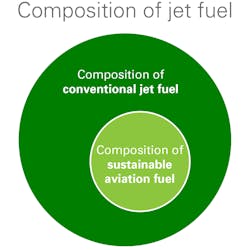Sustainable Aviation Fuel (SAF) – Specifications and Composition
We are often asked whether a particular turbine aircraft can use Sustainable Aviation Fuel (SAF) or whether one SAF fuel can be mixed with another. The answer to both is yes, as SAF is certified to the same global specifications as conventional jet.
Product quality advisor, Dr. Andrew Glendinning, and aviation fuels research and development manager, Dr. Alisdair Clark, provide further detail into what to expect from SAF as a ‘drop-in’ fuel.
Overview
SAF is jet fuel (aviation turbine fuel – AVTUR) which uses a proportion of sustainable feedstock in place of conventional crude-oil (fossil) feedstocks for manufacture. Using SAF results in a reduction in lifecycle carbon emissions compared to the conventional jet fuel it replaces.
The sustainable feedstock is called synthesized kerosene (SK) as the manufacturing process ‘synthesises’ (makes) the kerosene component from the sustainable feedstock according to aviation regulations. To meet jet specifications SK is blended with traditional jet fuel at concentrations up to 50%; the result is SAF.
The molecules in the fuel blend are identical to the molecules in conventional jet fuel as the approved synthesis routes have been carefully reviewed by the aviation industry, aircraft and engine manufacturers, regulators and military. There are no new materials in SAF which have not existed in jet fuel for decades, the fuel being within known parameters:
Specifications
ASTM and UK Defence Standard (Def-Stan) specifications dominate the majority of jet fuel sold across the world. This ensures aircraft flying globally can access fuel of a suitable and standard quality. The aviation fuel industry has designated ASTM D7566 as the governing specification for SK and SAF. ASTM D7566 is updated regularly as new manufacturing processes are approved for SK.
ASTM D7566, has been incorporated into the existing global jet fuel specifications ASTM D1655 and Def-Stan 91-091. This means that any SK manufactured using ASTM D7566 and then blended into SAF can be sold to customers as meeting the jet fuel specification, ASTM D1655 and/or Def-Stan 91-091.
Air BP SAF
SAF currently offered to customers by Air BP is manufactured from waste-based sustainable feedstocks such as used cooking oils and waste animal fat under the designation “HEFA-SPK” according to ASTM D7566 Annex 2. The SAF sold meets:
- ASTM D1655 – grades Jet A and Jet A-1
- Def-Stan 91-091 – grade Jet A-1
- ASTM D7566 – grades Jet A and Jet A-1
SAF in practice
SAF contains hydrocarbon molecules which have been present in jet for many years, the only difference being the use of a synthetic manufacturing route for part of the fuel blend. As such SAF is a ‘drop in’ standard jet fuel that is identical to conventional fuels at a molecular level, fully compatible in operations, and within the standard range of jet fuel properties. SAF is managed according to the same procedures and practices as conventional jet fuel using standards such as EI/JIG-1530, JIG1, JIG2, ATA103.
- Materials compatibility – fully compatible
- End-user compatibility – fully compatible
- Safety compatibility – no change
While a management of change (MOC) process is recommended for the introduction of SAF to any operation, there are no compatibility considerations where customers currently use ASTM D1655 or Def-Stan 91-091 as a basis for operations.

